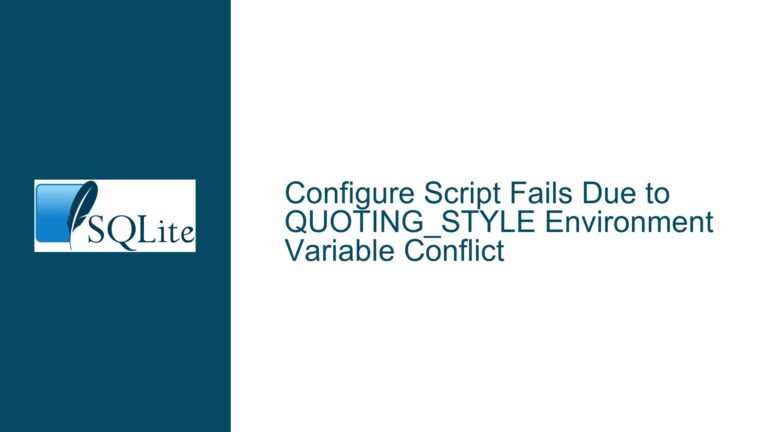SQLite Virtual Table Transaction Behavior for SELECT Queries
Why xBegin() is Not Invoked for SELECT Queries on Virtual Tables
The behavior of SQLite’s virtual table implementation can be perplexing, especially when it comes to transaction management. One of the most common points of confusion is why the xBegin() method is not invoked for SELECT queries on virtual tables, even though SQLite’s documentation states that all database operations, including reads, occur within a transaction. This post will delve into the intricacies of this behavior, explore the underlying reasons, and provide actionable solutions for developers who need to manage transactions effectively in their virtual table implementations.
The Role of xBegin() in Virtual Table Transactions
To understand why xBegin() is not called for SELECT queries, it’s essential to first grasp the role of the xBegin() method in SQLite’s virtual table API. The xBegin() method is part of the transaction management system for virtual tables. It is designed to signal the start of a transaction, allowing the virtual table implementation to prepare for changes that may need to be committed or rolled back later. This method is typically invoked when a write operation (such as an INSERT, UPDATE, or DELETE) is about to be performed on the virtual table.
However, when it comes to read operations, such as SELECT queries, SQLite does not invoke xBegin(). This is because read transactions in SQLite are handled differently from write transactions. Read transactions are lightweight and do not require the same level of preparation or cleanup as write transactions. Instead, SQLite ensures that read operations are consistent by using a snapshot of the database at the start of the transaction. This snapshot is maintained without the need for explicit xBegin() and xCommit() calls for read-only operations.
The distinction between read and write transactions is crucial for performance optimization. By not invoking xBegin() for read operations, SQLite avoids unnecessary overhead, allowing SELECT queries to execute more efficiently. However, this behavior can be confusing for developers who expect xBegin() to be called for all types of transactions, including reads.
The Implications of xBegin() Absence in SELECT Queries
The absence of xBegin() for SELECT queries has several implications for virtual table implementations. First, it means that developers cannot rely on xBegin() to initialize resources or set up transaction states for read operations. Instead, they must use other methods, such as xOpen() and xClose(), to manage the lifecycle of read transactions.
Second, the lack of xBegin() for SELECT queries can complicate the implementation of virtual tables that need to interact with external systems, such as a PostgreSQL database. In such cases, developers may need to map SQLite transactions to the external system’s transactions. Without xBegin() being called for read operations, it becomes challenging to determine when a read transaction starts and ends in the external system.
Third, the behavior can lead to inconsistencies when virtual tables are used as caches or when they need to participate in transactions involving other tables. For example, if a virtual table is used to cache data from another table, the absence of xBegin() for SELECT queries can make it difficult to ensure that the cache remains consistent with the underlying data.
Managing Transactions Without xBegin() for SELECT Queries
Given that xBegin() is not invoked for SELECT queries, developers must adopt alternative strategies to manage transactions effectively in their virtual table implementations. One approach is to treat the xOpen() and xClose() methods as the start and end of read transactions. These methods are guaranteed to be called for read operations, making them suitable for initializing and cleaning up resources associated with read transactions.
For example, in a virtual table that interfaces with a PostgreSQL database, the xOpen() method could be used to start a read transaction in PostgreSQL, while the xClose() method could be used to commit or roll back the transaction. This approach ensures that read operations are properly managed, even though xBegin() is not called.
Another strategy is to use explicit transactions for operations that require xBegin() to be called. For instance, if a virtual table needs to participate in a write transaction, the application can explicitly start a transaction using the BEGIN statement. This will cause SQLite to invoke xBegin() for the virtual table, allowing the implementation to prepare for the write operation.
In cases where a virtual table acts as a cache and needs to participate in transactions involving other tables, developers can use workarounds such as issuing a fake INSERT statement to trigger xBegin(). While this approach is not ideal, it can be effective in ensuring that the virtual table is included in the transaction.
Handling Edge Cases and Ensuring Consistency
One of the challenges of managing transactions in virtual tables is handling edge cases, such as when a virtual table is modified from within its own implementation. For example, if a virtual table attempts to insert data into itself during a SELECT query, SQLite may call xSync() and xCommit() without ever calling xBegin(). This behavior can lead to inconsistencies and errors in the virtual table implementation.
To address this issue, developers should ensure that their virtual table implementations are robust and can handle unexpected calls to xSync() and xCommit(). One way to do this is to maintain a transaction state within the virtual table implementation. This state can be used to determine whether a transaction is in progress and whether xBegin() has been called. If xSync() or xCommit() is called without a prior xBegin(), the implementation can take appropriate action, such as rolling back any changes or logging an error.
Another approach is to avoid modifying the virtual table from within its own implementation. Instead, developers can use external mechanisms, such as triggers or application-level logic, to manage updates to the virtual table. This approach reduces the risk of unexpected behavior and ensures that transactions are handled consistently.
Best Practices for Virtual Table Transaction Management
To ensure that virtual table implementations are robust and performant, developers should follow several best practices when managing transactions:
Use
xOpen()andxClose()for Read Transactions: SincexBegin()is not called forSELECTqueries, developers should usexOpen()andxClose()to manage read transactions. These methods provide a reliable way to initialize and clean up resources associated with read operations.Explicitly Start Transactions for Write Operations: For write operations, developers should explicitly start a transaction using the
BEGINstatement. This ensures thatxBegin()is called and that the virtual table is properly prepared for the write operation.Maintain a Transaction State: Developers should maintain a transaction state within their virtual table implementation. This state can be used to track whether a transaction is in progress and whether
xBegin()has been called. This information is crucial for handling edge cases and ensuring consistency.Avoid Modifying the Virtual Table from Within Its Implementation: To reduce the risk of unexpected behavior, developers should avoid modifying the virtual table from within its own implementation. Instead, they should use external mechanisms, such as triggers or application-level logic, to manage updates to the virtual table.
Handle Edge Cases Gracefully: Developers should ensure that their virtual table implementations can handle edge cases, such as unexpected calls to
xSync()andxCommit(). This includes maintaining a transaction state and taking appropriate action when these methods are called without a priorxBegin().Test Thoroughly: Virtual table implementations should be thoroughly tested to ensure that they handle transactions correctly. This includes testing read and write operations, as well as edge cases such as modifying the virtual table from within its own implementation.
By following these best practices, developers can create virtual table implementations that are robust, performant, and consistent with SQLite’s transaction management model.
Conclusion
The behavior of SQLite’s virtual table API can be complex, especially when it comes to transaction management. The fact that xBegin() is not invoked for SELECT queries can be confusing, but it is a deliberate design choice aimed at optimizing performance for read operations. By understanding the underlying reasons for this behavior and adopting appropriate strategies for managing transactions, developers can create virtual table implementations that are both efficient and reliable.
Whether you’re working with a virtual table that interfaces with an external database or using a virtual table as a cache, the key is to use the right methods for managing transactions and to handle edge cases gracefully. By following the best practices outlined in this post, you can ensure that your virtual table implementations are robust and consistent, even in the face of SQLite’s unique transaction management behavior.






